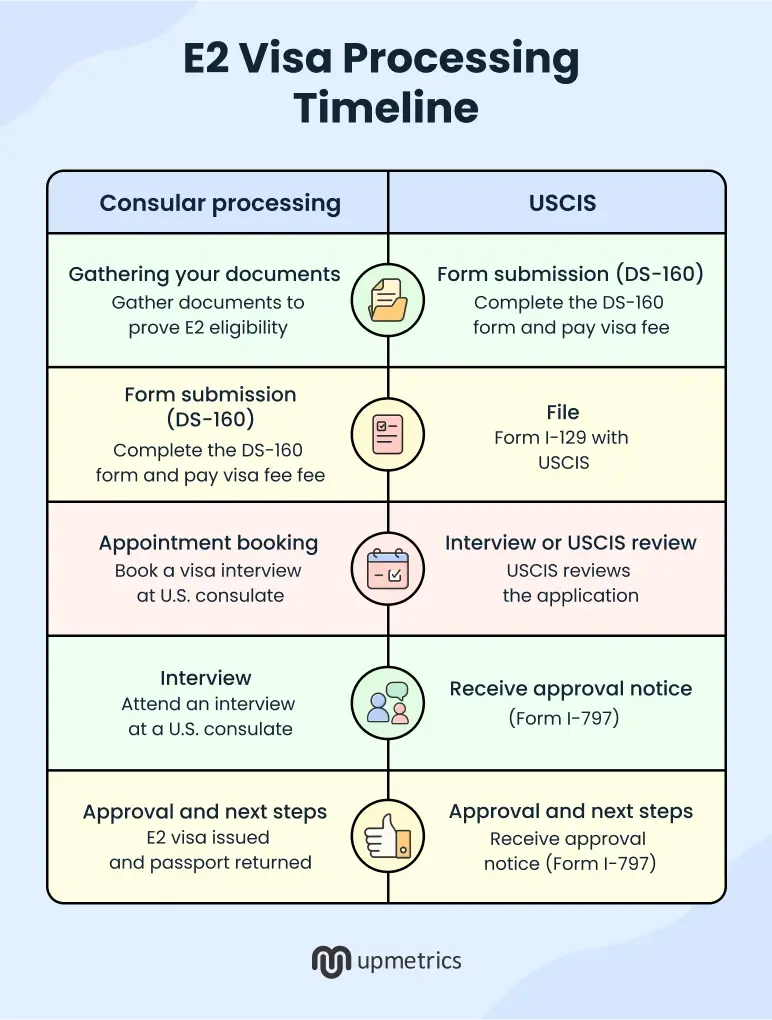We’ve seen entrepreneurs wait and wait, wishing they get that email reply saying “congratulations, your visa has been approved”.
The application & visa approval process for them is like:
Step 1: Submit forms. Step 2: Wait. Step 3: Hope.
To ensure you’re not one of them, here’s a detailed breakdown of the E2 visa processing time. For both consular processing and USCIS change of status.
Here’s a snapshot for a quick answer, followed by a detailed timeline breakdown.
How long does the E2 visa process take?
The E2 visa processing time typically ranges from 4-8 weeks after submitting your application, though this can vary significantly depending on where you apply.
There are two ways to apply for an E2 visa:
- Consular processing if you’re outside the U.S.
- Change of status if you’re already in the U.S. on a valid visa
Most applicants choose consular processing because it leads to a visa stamp in your passport. You can leave and re-enter the U.S. freely. With the status change, you get E2 status inside the U.S., but not a visa stamp. If you travel, you’ll still need to apply through a consulate later.
Now, the timelines,
| Route | What it means | Estimated processing time |
|---|---|---|
| Consular processing | Apply through a U.S. embassy or consulate | 2 to 5 months (depending on the country) |
| Change of status (USCIS) | Apply from inside the U.S. via Form I-129 | 2 to 3 months (can take longer) |
That said, these timelines are tentative, not set in stone. Your actual wait can stretch if the embassy is backlogged, your documents need fixing, or USCIS sends a Request for Evidence (RFE).
E2 visa timeline for consular processing (Outside the U.S.)
If you’re applying from outside the U.S., you’ll go through consular processing. You’ve to fill out your application with a U.S. consulate in your country, attend an in-person visa interview, and get your passport stamped with the E2 visa.
Here’s how the timeline usually breaks down:
Step 1: Gathering your documents
Start by organizing everything that proves your E2 eligibility. This includes your passport, E2 visa business plan, investment proof (bank statements, wire transfers, invoices), company registration documents, and financial forecasts.
You’ll also need ownership documents that show you own at least 50% of the U.S. business. Getting everything together usually takes 2 to 3 weeks.
You won’t need to fill out the DS-160 form yet, but once you have your documents taken care of, you will fill it out and receive the confirmation page, which you will require to book your visa appointment.
Avoid costly E2 visa rejections
Get a compliant business plan from experts
Plans starting from $14/month

Step 2: Fill out the DS-160 form and pay the visa fee
Once your documents are prepared, you will fill out the DS-160 form online, pay the E2 visa cost (the non-refundable Machine Readable Visa fee), and retain the receipt. This step doesn’t take long in itself, but you must take a few days to review everything carefully before submitting.
Step 3: Booking a consulate appointment
After your DS-160 is submitted, you can schedule a visa interview with a U.S. consulate. Timelines vary a lot depending on location.
In countries like Germany or Singapore, you might get an open slot in a week. But in places like Nigeria or India, you could wait 4 to 6 weeks, sometimes longer. Check the consulate’s site for current wait times. On average, this step takes 1 to 6 weeks.
Step 4: Going for the visa interview
At the interview, you’ll need to explain your business, show proof of your investment, and show ties to your home country. Some consular officers decide on the spot and keep your passport.
Others take a few days to respond. In straightforward cases, this part takes less than a week. But if your case gets flagged for extra review (called Administrative Processing or 221g), you could be looking at 1 to 6+ additional weeks.
Step 5: Passport return and visa stamping
Your passport will be stamped and returned to you once it is approved. For most countries, this will take 3 to 10 business days, although some consulates do offer expedited pick-up or courier service.
The entire E2 visa process generally takes 4 to 12 weeks, depending on how quickly you get your documents ready and how quickly your consulate sets appointments and makes decisions.
E2 visa timeline for change of status (Inside the U.S.)
If you’re already in the U.S. and want to change to E2 status without leaving the United States, you’ll apply directly with USCIS instead of a consulate. This keeps you in the United States legally in E2 status but doesn’t give you a visa stamp.
Should you leave the United States in the future, you’ll still need to apply for the actual visa at a U.S. consulate outside of the United States.
Here is how it goes:
Step 1: Filing your application
You’ll file Form I-129 along with an E2 Classification Supplement and all the E2 visa requirements, including your business and investment documents. This will include your business plan, proof of investment, financial projections, and other proof that is required.
If you are changing from another status (e.g., F-1, B1/B2, or H-1B), this application officially requests the status change to E2. You may file it yourself or have your immigration attorney do so.
This can take 1 to 3 weeks, depending on how well-prepared you are and if you are doing it yourself or hiring someone to do it for you.
E2 visa delays are costing you time and money
Navigate the application process with confidence
Plans starting from $14/month

Step 2: USCIS processing timeline
Once your application is filed, it enters the USCIS processing queue. Regular processing currently takes three to six months for E2 change of status applications. However, it varies with USCIS’s workload and could be different throughout the year.
If you need a faster decision, you can have E2 visa premium processing time reduced to 15 calendar days for an additional $2,805. USCIS will process it in 4 to 6 months after it’s filed under regular processing.
Learn more about premium processing.
However, if USCIS issues a Request for Evidence (RFE) asking for additional documentation, the premium processing clock stops until you respond. Once you submit your response, USCIS has 15 days to make a final decision.
But if USCIS issues a Request for Evidence (RFE) asking for additional evidence, the 15-day premium processing clock is held in abeyance when you respond. Once you respond, USCIS has 15 days to make a final decision.
Step 3: Receiving your approval
The last step is to await the response from USCIS with your approval. USCIS will mail you Form I-797, your approval notice, once approved. The notice is your proof of E2 status and will permit you to lawfully conduct business in the United States. You can begin or continue your business activities immediately upon receiving this approval.
Remember that this notice of approval is not the same as having an E2 visa stamp. In case you would like to go abroad, you will have to apply for the real E2 abroad at a U.S. consulate and then return to the United States.
If you process it normally, including E2 visa renewal processing time in future filings, the entire process normally takes 4 to 8 months from end to end. With premium processing, it will normally take 3 to 4 weeks, as long as there are no delays or requests for additional evidence.

What slows down the E2 visa process?
No one enjoys waiting as long as possible for their E2 visa, but a variety of things can take weeks or even months from your timeline.
Knowing what delays are possible helps you prepare and steer clear of the most common pitfalls, especially if you’re also curious about E2 visa to green card processing time or planning future adjustments.
Here are some:
1. Backlogs at specific consulates
Popular consulates in major business centers often get swamped with applications, creating natural bottlenecks.
One location might wrap up your case in four to six weeks, while another takes three to four months for virtually identical applications, usually depending on how many E2 cases they typically handle and their current staffing levels.
2. Missing or unclear documents
When consular officers or USCIS reviewers find missing documents or confusing information, they send you a request for more evidence, and that stops your case cold until you respond. These documentation problems usually centre around financial records that don’t tell a clear story.
3. Incomplete or weak business plans
Immigration officers can spot generic, cookie-cutter plans immediately, and they don’t look favourably on applications that appear rushed or incomplete. Business plans that skimp on important components almost always trigger requests for more information.
Using dedicated business planning software like Upmetrics can help ensure your plan includes all the necessary components and financial projections that immigration reviewers expect to see while also creating a document that actually serves your business beyond just the visa application.
4. Long appointment wait times
Getting an appointment at some consulates can take months, while others may have openings within a few weeks. Availability changes often due to demand, holidays, and staffing. If you need to reschedule or attend a follow-up interview, your timeline can stretch even further.
5. Getting real-time information
Even with a planned timeline, appointment availability can change unexpectedly. Consulates may cut slots due to staffing, holidays, or other adjustments with little notice. The U.S. State Department’s wait time tool offers estimates, but real availability often differs.
Say goodbye to boring templates
Build your business plan faster and easier with AI
Plans starting from $14/month

So…
Can I speed up the E2 visa process?
While you can’t control every aspect of E2 visa timing, several strategies can help you avoid unnecessary delays and potentially speed up your application. These approaches focus on being prepared, making smart choices, and taking advantage of available options.
1. Book appointments early
If you’re going the consular route, book your appointment as soon as you have a reasonable timeline for when your documents will be ready. Appointment slots fill up quickly at popular consulates, and waiting until everything is perfect often means adding weeks or months to your timeline.
2. Hire a lawyer or an experienced visa consultant
Immigration attorneys and experienced consultants can spot potential issues before you submit your application and help you avoid requests for additional evidence that commonly delay cases. The upfront investment often pays for itself by preventing costly delays and increasing your approval chances.
3. Submit a professional business plan
A well-crafted, comprehensive business plan that clearly demonstrates viability and job creation potential can significantly speed up your review process. Immigration officers can quickly assess professionally prepared plans.
4. Use premium processing for a change of status
If you’re applying for the change of status within the U.S., premium processing guarantees a decision within 15 calendar days for an additional $2,805. This option isn’t available for consular processing, but it can dramatically reduce your timeline if you’re already in the country and don’t need the visa stamp immediately.
5. Have all documents ready from the start
Properly organized documents help avoid the most common E2 delays. Clear financial records, proof of fund sources and transfers, and authenticated business and personal documents create a strong, coherent case and speed up processing.
6. Tap into current information
Reddit’s immigration forums and Telegram groups focused on E2 visas offer real-time updates about processing times, appointment availability, and recent changes at specific consulates. Members share current experiences and flag when particular locations are experiencing delays or have updated their requirements.
5 Common mistakes that slow things down
These frequent errors can add weeks or months to your E2 visa timeline. Most are completely avoidable with better planning and realistic expectations about the process.
1. Using free templates instead of a real business plan
Generic business plan templates from the internet are obvious to immigration officers. They can immediately spot template language, and it raises questions about the legitimacy of your business venture.
2. Booking an interview before the documents are ready
Scheduling your consular appointment before having all required documents properly prepared and authenticated often forces you to reschedule, losing your slot and adding months to your timeline.
3. Assuming timelines are the same across consulates
Different consulates have vastly different processing speeds and appointment availability, but many applicants choose based on convenience rather than efficiency. Some consulates consistently process E2 applications in 4-6 weeks, while others routinely take 3-4 months for identical cases.
4. Underestimating document authentication requirements
Many applicants underestimate the time needed to properly authenticate or apostille business documents for international use. It’s a process that can stretch over several weeks and involve multiple steps through various government agencies.
5. Providing incomplete financial documentation
Failing to clearly show where the investment funds came from and how they were transferred raises immediate red flags. Many applicants submit bank statements without clear transfers or financial records, which often leads to requests for more evidence and delays.
Final thoughts
The E2 visa process gets smoother when you plan around real timelines and avoid avoidable mistakes. Most delays stem from incomplete documentation, weak plans, or poor timing decisions that are completely within your control.
Your business plan deserves particular attention since it’s often the make-or-break element of your application. A comprehensive, professionally crafted business plan speeds up your E2 approval and serves as your actual roadmap for building a successful U.S. business.
Upmetrics helps ensure your plan includes all the financial projections and market analysis that immigration reviewers expect while creating a document that genuinely supports your business goals beyond just getting the visa.

